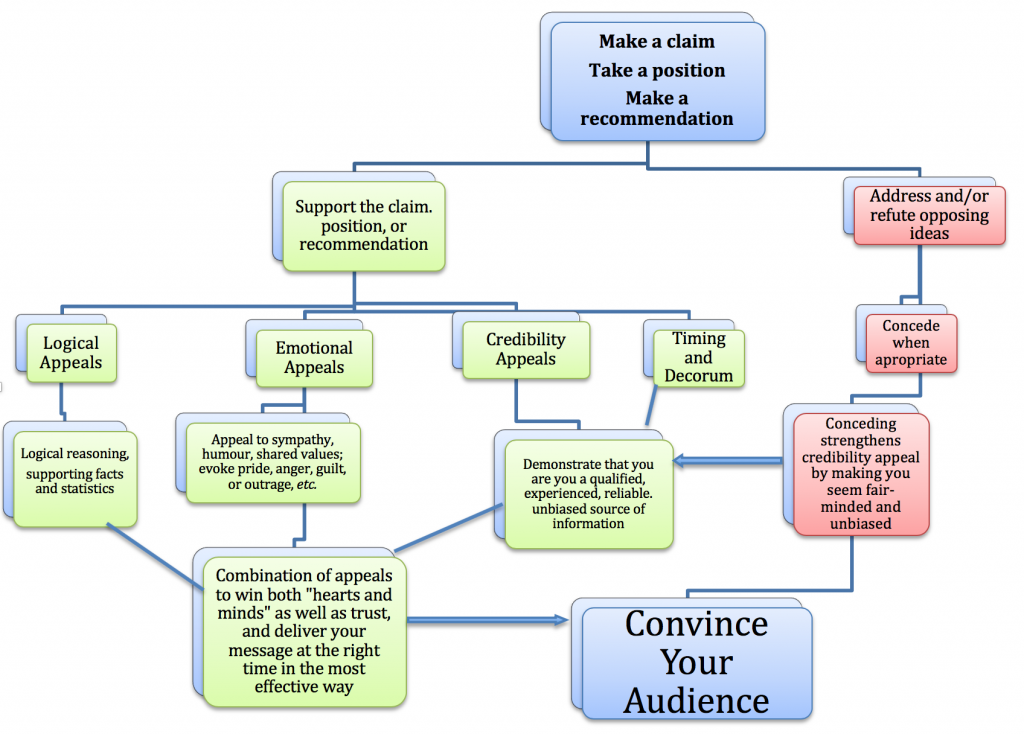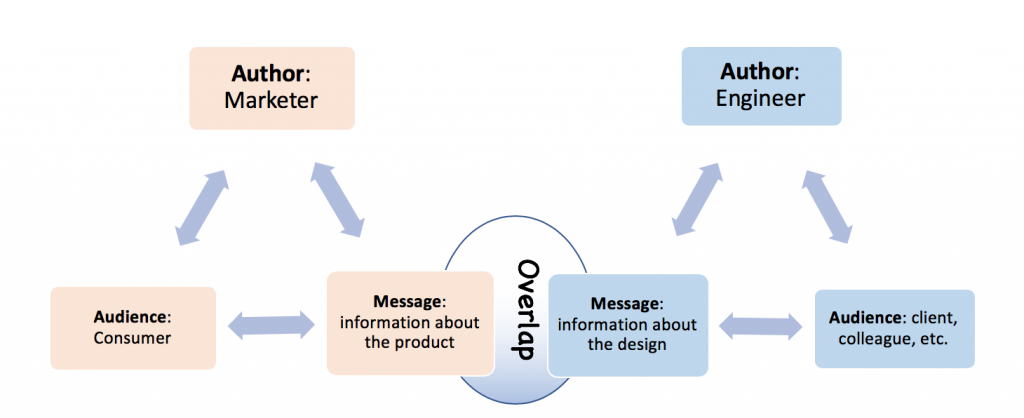2 2.3 Writing To Persuade
Sometimes, you may want to persuade your reader to take a particular action or position on an issue. To be effective, you should consider the following elements of persuasion, often referred to as Rhetorical Appeals. The ancient Greek words are ethos, pathos, logos, and kairos. These concepts are still critical in rhetoric studies today (see Figure 2.3.1):
- Ethos – Appeal to Credibility/Authority: this element of persuasion involves establishing your credibility, expertise, or authority to be making the argument. What experience or expertise do you have? What knowledge or skills do you possess? What’s your role within the organization, and/or in relation to the reader? Why should the reader trust you as a reliable, knowledgeable, authoritative, and ethical source of information?
- Pathos – Appeal to Emotion/Interest/Values: this element involves appealing to the emotions, values, and/or interests of the reader. How does your proposal benefit them? Why should they care about it? How does it relate to the goals of the organization? How can you build “common ground” with your reader? What will make your reader feel “good” about your project? How can you evoke emotions such as pride or outrage?
- Logos – Appeal to Reason/Logic: this element involves grounding your argument in logic, reason, and evidence. What evidence supports your claims? On what facts and data is your reasoning based? Arguments grounded in reason and evidence are often considered the strongest. Government organizations and companies alike generally like to make “evidence-based decisions.”
- Kairos – Appeal to Timeliness/Appropriateness: using this appeal means being aware of what is appropriate and timely in a given rhetorical situation. Sometimes, a well-crafted argument can fail because it comes at the wrong time. Kairos involves knowing what is “in” or “hot” right now, what is an important topic or issue, and how best to discuss it; knowing when it is the “right time” to broach a topic or propose an idea; knowing how to use the appropriate tone, level of formality and decorum for the specific situation.
Finding the appropriate blend of appeals is critical to making a successful argument; consider that when making your case, you often have to “win both hearts and minds”—so you’ll need to appeal to both emotions and logic, do whatever you can to show the reader that you are a trustworthy source of information, and present your argument at the most opportune time. In addition to these elements, you should also be mindful of the word choice and tone so that you are presenting a persuasive argument that is also constructive and conveys the appropriate tone for your intended audience, message, and purpose.

Avoiding Ad-Speak
“Ad-speak” refers to the kind of language often used in advertisements. Its aim is to convince consumers to buy something, whether they need it or not, hopefully without thinking too much about it. Because we hear this kind of rhetoric all the time, it easily becomes habit to use it ourselves. We must break this habit when communicating in professional contexts.
Ad-Speak tends to use strategies such as
- Emotional manipulation
- Logical fallacies
- Hyperbole
- Exaggeration or dishonesty
- Vague claims
- Incomplete or cherry-picked data
- Biased viewpoints
- Hired actors rather than professionals or experts as spokespeople.
As a student in a professionalizing program learning the specialized skills and developing the sense of social obligation needed to become a trusted professional, you should avoid using “sensational” language characteristic of marketing languge. Instead, when trying to persuade your reader, make sure you use quantifiable, measurable descriptors and objective language in your writing. You cannot determine how many units of “excellence” something has, or its quantifiable amount of “awesomeness,” “fantastic-ness,” or “extraordinariness.” Describing something as “incredible” literally means it’s unbelievable. So avoid using these kinds of words shown in Figure 2.3.2.

Find measurable terms like “efficiency” (in time or energy use), “effectiveness” at fulfilling a specific task, measurable benefits and/or costs, or even “popularity” as measured by a survey.
Communicating Ethically
In professional writing, communicating ethically is critically important. Ethical communications involves communicating from a place of accountability, responsibility, integrity, and values. If you are communicating ethically, you are demonstrating respect for your reader, the organizations you work for and with, and the culture and context within which you work. You also foster fairness and trust through honesty. Failure to maintain integrity and ethics can result in consequences ranging from damage to reputation, loss of work, lawsuits, criminal charges, and even tragic loss of life.
This is precisely why many professional associations have guidelines that govern the ethical behavior of their membership. Two such documents that may be relevant to you are the Faculty of Engineering’s “Standards for Professional Behavior” (.pdf) and the Association of Professional Engineers and Geoscientists of BC APEGBC Code-of-Ethics (.pdf). For example, take note of the portions of the APEGBC Code of Ethics that relate specifically to ethical communication.
- Provide an opinion on a professional subject only when it is founded upon adequate knowledge and honest conviction;
- Conduct themselves with fairness, courtesy and good faith towards clients, colleagues and others, give credit where it is due and accept, as well as give, honest and fair professional comment;
- Present clearly to employers and clients the possible consequences if professional decisions or judgments are overruled or disregarded;
- Extend public knowledge and appreciation of engineering and geoscience and protect the profession from misrepresentation and misunderstanding.”
It is important to become familiar with these standards of practice, and to consider how they impact communication practices. Remember that you are communicating in a professional context, and that comes with responsibility. Consider the different rhetorical situations diagrammed in Figure 2.3.3, one for a marketer and one for an engineer.

Clearly, there may be some overlap, but there will also be significant differences based on the needs and expectations of the audience and the kind of message being delivered. We hear marketing language so often that it is easy to fall into the habit of using it, even when it’s not appropriate. Make sure you are not using “ad-speak” when trying to persuade in a professional context.
Image descriptions
Figure 2.3.1 image description:
Use rhetorical appeals to convince your audience of a claim or recommendation you’ve made or a position you’ve taken. From there, you can support your claim using different types of appeals or address and refute opposing ideas.
To support the claim, position, or recommendation, you can use different types of appeals:
- Logical appeals: Use logical reasoning, supporting facts and statistics.
- Emotional appeals: Appeal to sympathy, humour, shared values, evoke pride, anger, guilt, or outrage, etc.
- Credibility appeals: Demonstrate that you are qualified, experienced, reliable, and an unbiased source of information.
- Timing and Decorum.
- Use a combination of appeals to win both “hearts and minds” as well as trust, and deliver your message at the time in the most effective way.
When addressing and/or refuting opposing ideas, it’s okay to concede where appropriate. Conceding strengthens credibility appeal by making you seem fair-minded and unbiased. You may need to draw on credibility appeals to show that you are qualified, experienced, and a reliable, unbiased source of information.
Supporting your position using different types of appeals and addressing opposing ideas will allow you to convince your audience.
Figure 2.3.3 image description:
When the marketer is the author, their audience is the consumer and their message is information about the product. When the engineer is the author, their audience could be a client or colleague, and their message is information about the design. There may be some overlap between the messages of the marketer and the engineer.

